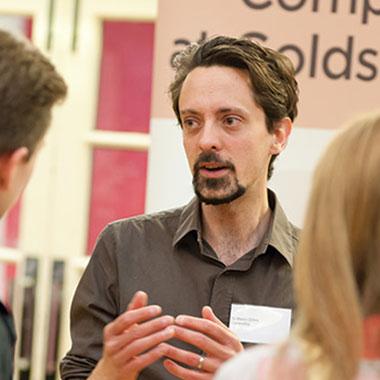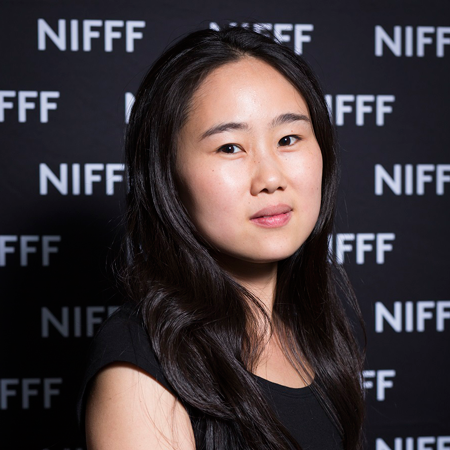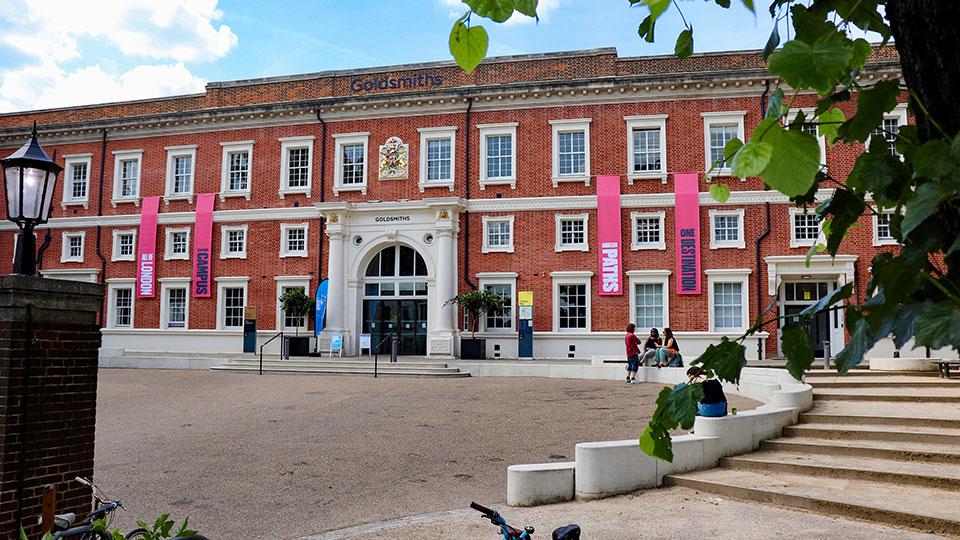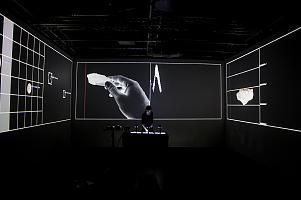MA/MSc
Virtual & Augmented Reality
Content navigation menu
Why study MA/MSc Virtual & Augmented Reality at Goldsmiths
Immersive experiences, including virtual and augmented reality, are the most exciting new mediums to emerge in the 21st century. On this Masters, you’ll be working on a once-in-a-lifetime challenge: shaping and pioneering a medium that’s already having a major impact on our society.
- You'll have the chance to choose between two distinct pathways, depending on your interests.
— 3D Graphics and User Experience Pathway (an MA)
— Programming and Computer Science Pathway (an MSc)
For each pathway, you can choose to complete either an internship or self-directed research project. - You’ll be creating virtual and augmented reality that is informed by both the technology and psychology of the medium, so you can create powerful experiences that make the most of its distinctive features.
- This technology is used in a huge variety of industries including medicine, advertising, journalism and mental health therapy. When you graduate you’ll have the skills to work in these industries, as well as in more traditional gaming and film roles.
- We treat virtual reality and augmented reality as interlinking technologies – you’ll be working in both areas and the various types of Mixed Reality that combine the two. You can also learn other areas of computing that can be applied to Virtual and Augmented Reality such as data visualisation, interactive art, games technology, machine learning and AI.
- This programme is co-led by two leading researchers in the area of XR research. You will be working with a strong team of 10+ XR researchers (researchers and PhD students) from the SeeVR Research lab.
- As well as being taught by leading experts in VR/AR experience, you’ll benefit from our links to an extensive network of VR companies. We regularly welcome them to campus to deliver talks.
- We offer a work placement programme that will help kick-start your VR career.
- You’ll have access to a dedicated V&AR lab. The facilities will be updated each year to keep up with technology but they currently include a range of high-end head mounted displays including Oculus Rift, HTC VIVE Pro and Windows MR, each with high end graphics PCs. You’ll also have access to mobile VR set ups (Oculus GO) and a professional motion capture suite that is synchronised with an HTC VIVE for full body-immersive experiences.
- Our general computing facilities include the HatchLab, our maker space that can be used for, among other things, fabricating custom VR input or output devices.
- We also offer an abridged online version of this course, which you can try before registering for the full-time postgraduate course. Find out more on Coursera.
Contact the department
If you have specific questions about the degree, contact Marco Gillies or Sylvia Xueni Pan.
Length
1 year full-time or 2-3 years part-time
Entry requirements
You should have (or expect to be awarded) an undergraduate degree of at least 2:1 standard in a relevant/related subject. You might also be considered if you aren’t a graduate or your degree is in an unrelated field, but you have relevant experience and can show you can work at postgraduate level.
Fees
Home - full-time: £12520
Home - part-time: £6260
International - full-time: £18560
Department
What you'll study
Compulsory modules
All students on this pathway take these modules:
| Module title | Credits |
|---|---|
| Virtual Reality | 15 credits |
| Augmented Realities | 15 credits |
| Advanced Topics in Virtual and Augmented Reality | 15 credits |
| Introduction to Modelling and Animation | 15 credits |
You then choose one of the following:
| Module title | Credits |
|---|---|
| Games Programming 1 | 15 credits |
| or | |
| Visual Game Development | 15 credits |
Optional modules
You'll also take a further 45 credits across a selection of modules in the Department of Computing.
| Module title | Credits |
|---|---|
| Programming for Artists and Designers | 15 credits |
| Mathematics for Games and V&AR | 15 credits |
| Approaches to Play 1 | 15 credits |
| Data and Machine Learning for Artistic Practice | 15 credits |
| Modelling and Animation 2 | 15 credits |
| Games Programming 2 | 15 credits |
| Game Design and Analytics | 15 credits |
| Graphics for Games and V/AR | 15 credits |
| Programming for Game Engines | 15 credits |
| Alternative Game Controller Design | 15 credits |
| Audio Experience for Games | 15 credits |
| Approaches to Play 2 | 15 credits |
| Interactive Narrative and Digital Storytelling | 15 credits |
| Escape Room Design and Immersive Theatre | 15 credits |
| Motion Capture Techniques and Digital Embodiment | 15 credits |
| Applied AI for Industry | 15 credits |
Internship or research
You'll then complete one of the following:
- A 60-credit internship project in virtual reality
- A 60-credit self-directed research project
Note about optional modules (if available): The above is indicative of the typical modules offered, but is not intended to be construed or relied on as a definitive list of what might be available in any given year. The module content and availability is subject to change.
Teaching and assessment
Taught sessions and lectures provide overviews of themes, which you are encouraged to complement with intensive reading for presentation and discussion at seminars.
Assessments build on lectures and seminars so you are expected to attend all taught sessions to build knowledge and your own understanding of your chosen discipline.
All assessed work is accompanied by some form of feedback to ensure that your work is on the right track. It may come in a variety of forms ranging from written comments on a marked essay to oral and written feedback on developing projects and practice as you attend workshops.
Entry requirements
You should have (or expect to be awarded) an undergraduate degree of at least upper second class standard in a relevant/related subject.
You might also be considered for some programmes if you aren’t a graduate or your degree is in an unrelated field, but have relevant experience and can show that you have the ability to work at postgraduate level.
Will you need a portfolio?
To apply for the MA route, you’ll be required to submit a portfolio of relevant work as part of your application. This can include any form of creative work, ideally using digital tools such as existing VR, AR or games work, but also film production, design work or fine art.
To apply for the MSc route, you’re welcome to submit a portfolio to support your application, but this is optional.
In some instances, we may ask to see more of your work or attend a short interview.
International qualifications
We accept a wide range of international qualifications. Find out more about the qualifications we accept from around the world.
If English isn’t your first language, you will need an IELTS score (or equivalent English language qualification) of 6.5 with no element lower than 6.0 to study this programme. If you need assistance with your English language, we offer a range of courses that can help prepare you for postgraduate-level study.
How to apply
Apply directly to Goldsmiths using our online application system.
Before submitting your application you’ll need to decide whether you want to apply for the MSc or MA, and whether you want to take the Internship or Research option.
You will need to have:
- Details of your academic qualifications
- The email address of your referee who we can request a reference from, or alternatively a copy of your academic reference
- Copies of your educational transcripts or certificates
- A personal statement – this can either be uploaded as a Word Document or PDF, or completed online. Please see our guidance on writing a postgraduate statement
You'll be able to save your progress at any point and return to your application by logging in using your username/email and password.
When to apply
We accept applications from October for students wanting to start the following September.
We encourage you to complete your application as early as possible, even if you haven't finished your current programme of study. It's very common to be offered a place that is conditional on you achieving a particular qualification.
Late applications will only be considered if there are spaces available.
If you're applying for funding, you may be subject to an earlier application deadline.
Selection process
Admission to many programmes is by interview, unless you live outside the UK. Occasionally, we'll make candidates an offer of a place on the basis of their application and qualifications alone.
Find out more about applying.
Fees and funding
Annual tuition fees
These are the PG fees for students starting their programme in the 2024/2025 academic year.
- Home - full-time: £12520
- Home - part-time: £6260
- International - full-time: £18560
If your fees are not listed here, please check our postgraduate fees guidance or contact the Fees Office, who can also advise you about how to pay your fees.
It’s not currently possible for international students to study part-time under a student visa. If you think you might be eligible to study part-time while being on another visa type, please contact our Admissions Team for more information.
If you are looking to pay your fees please see our guide to making a payment.
Funding opportunities
Explore the Goldsmiths scholarships finder to find out what other funding you may be eligible for.
Paying your fees
Find out about paying your tuition fees.
If you are a UK student you may be eligible for a postgraduate loan.
Meanwhile our Careers Service can also offer advice on finding work during your studies.
Additional costs
In addition to your tuition fees, you'll be responsible for any additional costs associated with your course, such as buying stationery and paying for photocopying. You can find out more about what you need to budget for on our study costs page.
There may also be specific additional costs associated with your programme. This can include things like paying for field trips or specialist materials for your assignments. Please check the programme specification for more information.
Facilities
In the Department of Computing, we have a great range of labs and facilities.
We have a state-of-the-art VR lab with 8 sets of high-end VR HMDs (e.g., VIVE Pro 2, Valve Index). There are also standalone HMDs students can borrow (Quest 2, Quest Pro). You can benefit from our own in-house 12-camera Motion Capture System (Optitrack).
You can also access other computing facilities such as a large-scale projection space (the Siml lab), and our fabrication lab with 3D printers, laser cutters, and woodwork equipment.
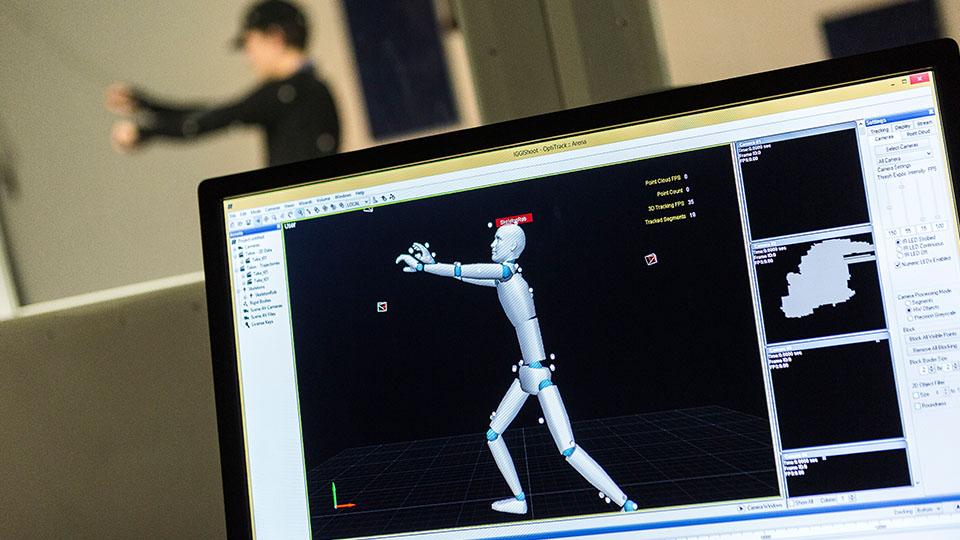
Motion Capture Lab
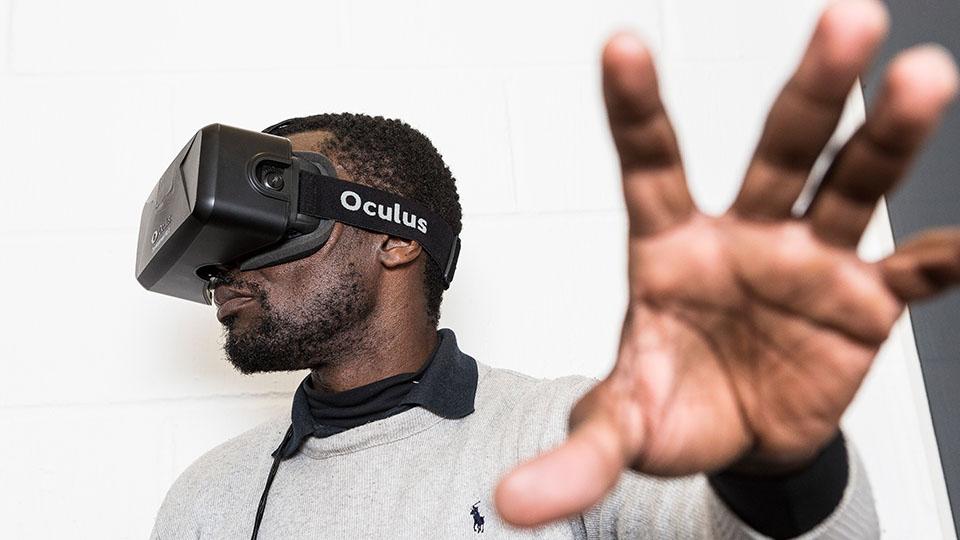
Virtual Reality
Careers
Where this degree can take you
Our programme opens multiple career options including:
- Creator of Virtual and Augmented Reality experiences for digital agencies specialising in contract work
- Virtual and Augmented Reality artist working either independently or within the context of creative SMEs or larger organisations such as the BBC
- Games Developer specialising in Virtual and Augmented Reality Games on PC, mobile, or Sony PlayStation VR
- Virtual and Augmented Reality creator associated with more traditional platforms, for example creating VR experiences linked to film, television or games
- Designer of Virtual or Mixed Reality tools for education, for example medical training
- Designer of Virtual or Mixed Reality apps for domains such as healthcare (including mental health), engineering or social media/remote conferencing
As well as technical developer roles, once you graduate you would also be well placed for roles such as junior producers in all these industries
You may also gain the skills to develop your independent research questions, which could lead to postgraduate research. Many of our graduates have now progressed on to doing a PhD in this area.
Placement opportunities
Students are able to take a paid placement in place of an academic final project. We have a strong network of VR and AR companies and studios and have a succeeded in placing a large number of students, the majority of which have gone on to permanent jobs in the organisation. In additional to paid commercial placement, we offer the option of projects that are sponsored and co-supervised by non-profit organisations (eg healthcare) or other academic departments or institutions.
